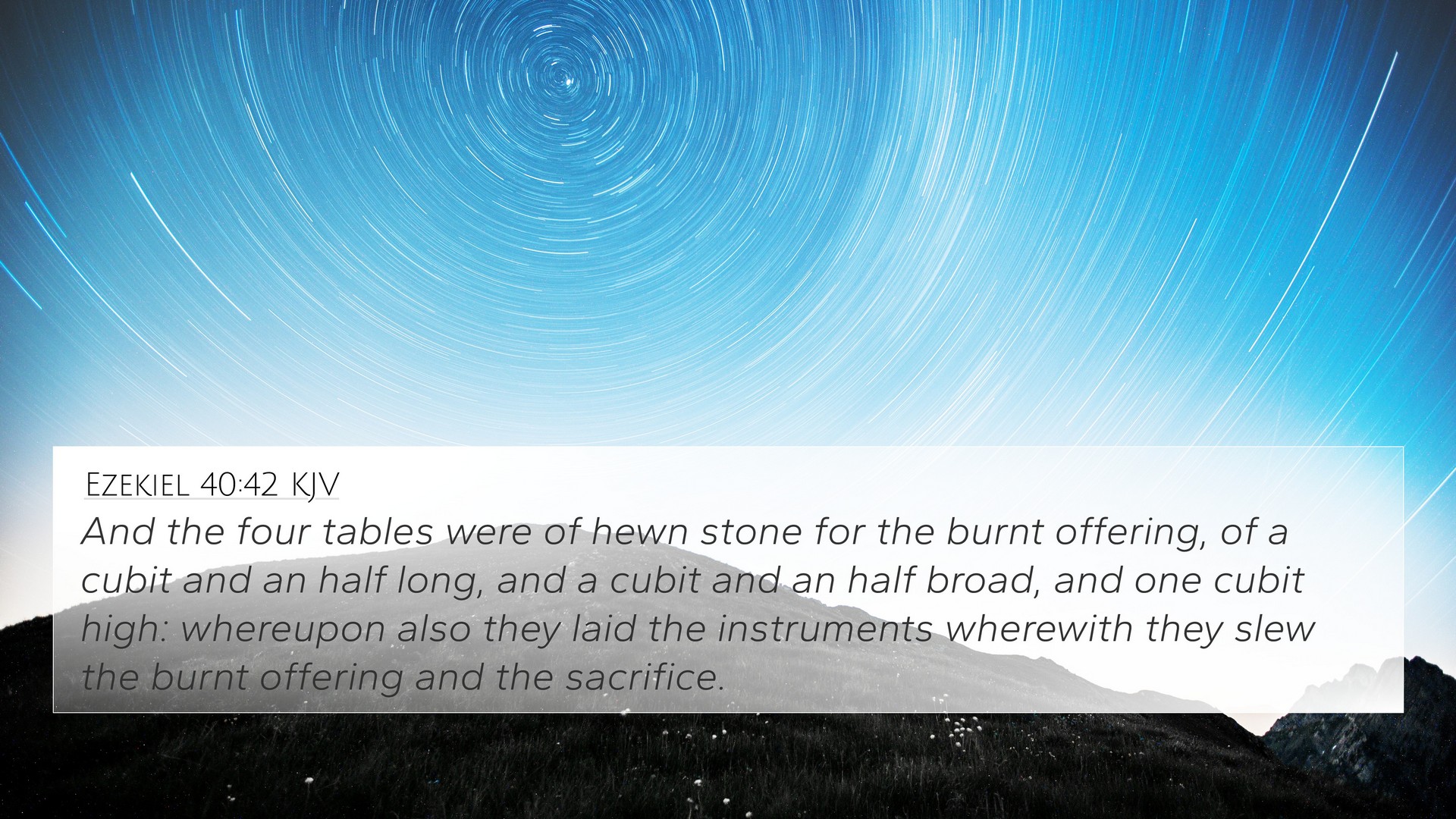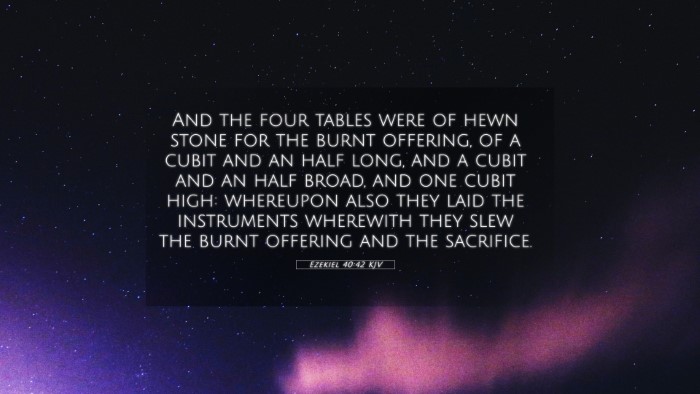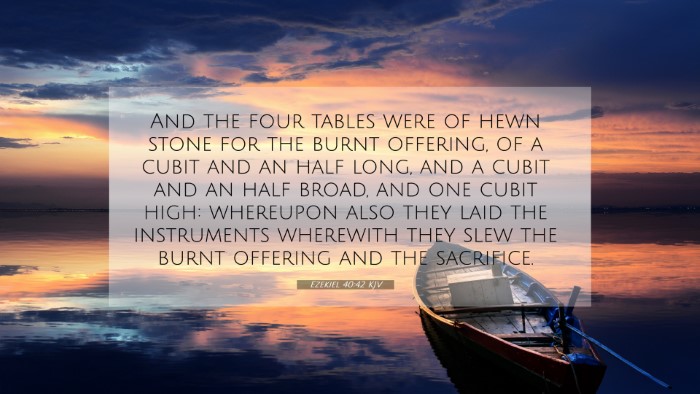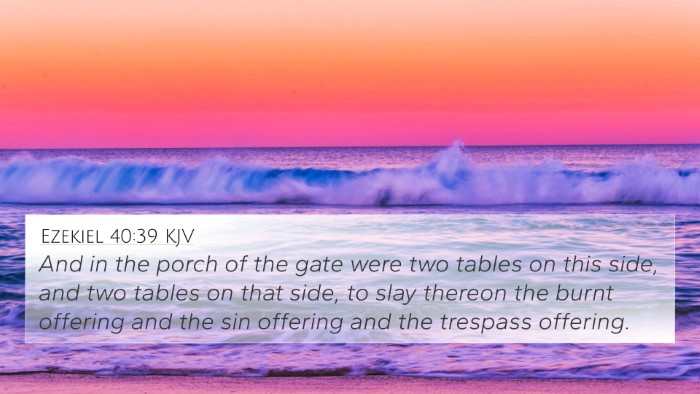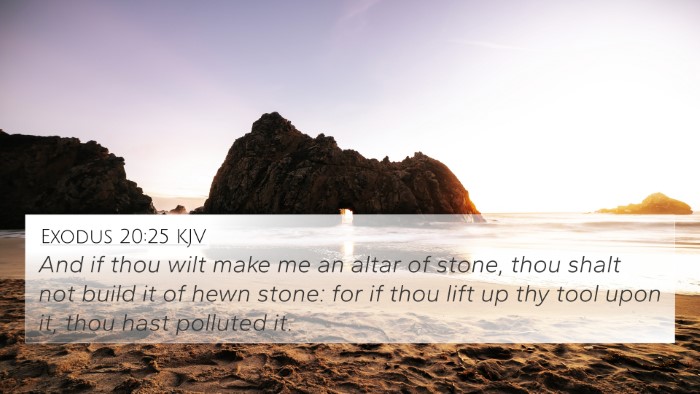Ezekiel 40:42 - A Summary of Meaning and Interpretation
Bible Verse: Ezekiel 40:42
"And the four tables were of hewn stone for the burnt offerings, of a cubit and a half long, and a cubit and a half broad, and a cubit and a half high; whereupon also they laid the instruments wherewith they slew the burnt offering and the sacrifice."
Overview of Ezekiel 40:42
This verse describes specific dimensions and purposes of tables used in the temple for burnt offerings. It reflects the meticulous detail with which God instructed Ezekiel about the future temple's design. The mention of "four tables" implies a structured and organized approach to worship, highlighting the importance of sacrifices in maintaining a covenant relationship with God.
Commentary Insights
Matthew Henry's Commentary
Matthew Henry emphasizes that the mention of the tables and their dimensions signifies the seriousness of the sacrificial system. He notes that the specifics of their construction reflect God's authority and the need for reverence in worship. The four tables symbolize the sufficiency of God’s provision for the people’s needs regarding atonement and closeness to Him.
Albert Barnes' Notes
Albert Barnes highlights the practical aspect of these tables. He points out that their measurements indicate a significant amount of space allocated for the sacrificial offerings. Barnes also discusses how the use of stone indicates durability and permanence, suggesting that the means of approaching God through sacrifice is not to be taken lightly and should be enduring and reliable.
Adam Clarke's Commentary
Adam Clarke elaborates on the functionality and symbolism of the burnt offerings. He explains that the act of offering sacrifices on these tables illustrates the Israelites' acknowledgement of sin and their need for redemption. The instruments laid upon them represent the seriousness of sin and the required response to achieve atonement, drawing a parallel to the ultimate sacrifice of Christ.
Cross-Referencing Biblical Texts
Understanding Ezekiel 40:42 also involves exploring connections between Bible verses that resonate with themes of sacrifice, worship, and atonement. Below are some relevant cross-references:
- Leviticus 1:5: Details the process of offering a burnt sacrifice and reflects the importance of a proper sacrificial system.
- Hebrews 10:4: States that the blood of bulls and goats cannot take away sins, leading to a discussion of Christ's ultimate sacrifice.
- Exodus 27:1-2: Foundational descriptions of the altar of burnt offerings, relating to the physical aspects of worship.
- 1 Peter 2:5: Christians are referred to as living stones, a spiritual house, connected to the theme of sacrificial worship.
- Revelation 8:3-4: A vision of heavenly worship that parallels the earthly sacrifices with prayers ascending to God.
- Romans 12:1: Encouragement to present our bodies as living sacrifices, linking New Testament worship with Old Testament practices.
- Matthew 5:24: An exhortation on the importance of reconciliation before offering gifts at the altar, emphasizing the relational aspect of the sacrifice.
Understanding the Thematic Connections
In studying Ezekiel 40:42, it is beneficial to explore thematic Bible verse connections. The theme of sacrifice runs throughout both the Old and New Testaments. Here are significant thematic connections illustrated through scriptural references:
- Atonement and Sacrifice: The need for sacrifice for sin (Hebrews 9:22).
- Worship and Reverence: Altars as places of worship (Psalm 51:17).
- God's Holiness: The call for holiness in worship practices (1 Peter 1:16).
- Reconciliation with God: The importance of a right relationship with Him (Matthew 28:19).
Tools for Bible Cross-Referencing
To deepen your understanding of Ezekiel 40:42 and its implications, utilizing tools for Bible cross-referencing can enhance your study. These may include:
- Bible Concordance: An invaluable resource for finding specific themes or words throughout scriptures.
- Bible Cross-Reference Guide: Helps link similar scriptures and themes effectively.
- Cross-Reference Bible Study: A methodical approach to study by comparing related verses.
- Bible Reference Resources: Tools like study Bibles often include marginal references to assist with cross-referencing.
Conclusion
The study of Ezekiel 40:42 reveals deep layers of meaning regarding worship, sacrifice, and God’s specifications for the temple’s functions. By employing various cross-referencing methods, one can uncover the broader biblical narrative that intertwines themes of atonement, reverence, and relational integrity with God. The insights from esteemed commentators like Matthew Henry, Albert Barnes, and Adam Clarke provide a solid foundation for understanding the significance of this verse in the larger context of the Scripture.
In summary, Ezekiel 40:42 not only serves as a historical reference within Israel’s worship framework but also points believers today toward a deeper understanding of sacrifice and commitment in their spiritual lives.
